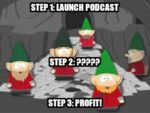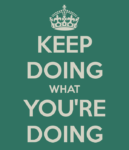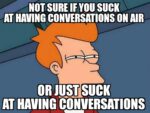*Disclaimer: We don’t know what we are doing
So let’s get one thing straight, before we started our podcast, we’ve never listened to one single podcast in our entire lives. Not one. Not ever. It just wasn’t on our collective radar.
Over the past two years, multiple people have told us we are, and I quote, “breaking all the rules of podcasting”. We didn’t even know that there were “rules of podcasting”.
We have done 93 two-hour episodes to date; episode one currently has 5,800 listens while our latest podcast has 280,000+. Our grand total has eclipsed 5M total listens to date. Ask us how we did this and we will quickly say, “I have no idea.” When I tell Dave a podcast just hit “so and so” many listens and his reply is always “that makes my head hurt”.
So the following tips aren’t necessarily us creating the rules we didn’t know existed, or trying to lay out a roadmap for you – this is merely a recap of the guidelines we followed for ourselves and what we did so hopefully this will help you suck less at starting your own podcast…
Feel free to disagree with us as again, we aren’t experts or gurus or ninjas in any of this. You might not even agree that we’re the ones to be telling anyone how to suck less because you think we suck. And that’s okay too. We’re happy with where we are and what we’re doing, and that’s really all that matters to anyone looking to do this anyway.
Please note: This is not a “recipe for success”. We’re not saying we’re either “right” or “wrong”. The following is simply the path we followed and how we answer the question “How did you do what you’ve done?”
- Figure out your game plan
 We based our show on our networking group. A little IT, a little networking, a lot of job recruiting, all with a beer in our hand. We slowly branched into other worlds of geekdom including comics, gaming, pop culture, beer…basically anything we felt an IT geek would talk about at a bar.
We based our show on our networking group. A little IT, a little networking, a lot of job recruiting, all with a beer in our hand. We slowly branched into other worlds of geekdom including comics, gaming, pop culture, beer…basically anything we felt an IT geek would talk about at a bar.
We thought “the sales guy vs. the IT guy” would be money…it wasn’t. It was awkward and it sucked.
We figured doing a mega IT deep-dive would be good, and again…no…it was rather boring.
So we settled on IT bar talk, and that was where we had the most fun. So feel free to experiment, fail, and fail again. The worst thing that happens is that you shake your heads at each other and vow to never, ever do that again…which we’ve done more than once.
- Go into it with absolutely zero expectations
 We started and treated the podcast like we would treat bowling night: You show up, have some beers, talk about whatever with whoever’s in the room, laugh a lot, have some more beers, and go home. We didn’t go into it with some grandiose plan of podcast domination, we literally just said “OK” and away we went. None of us had any formal or informal training, and it was OK since we were going into it with the notion that we were simply taping our bar ramblings and boy oh boy, is this gonna be great!
We started and treated the podcast like we would treat bowling night: You show up, have some beers, talk about whatever with whoever’s in the room, laugh a lot, have some more beers, and go home. We didn’t go into it with some grandiose plan of podcast domination, we literally just said “OK” and away we went. None of us had any formal or informal training, and it was OK since we were going into it with the notion that we were simply taping our bar ramblings and boy oh boy, is this gonna be great!
- Build a community, don’t just have a show
 We see so many shows and talk to so many people that simply upload their podcast, post it on Facebook and wonder why they don’t have followers, or aren’t growing their listener base.
We see so many shows and talk to so many people that simply upload their podcast, post it on Facebook and wonder why they don’t have followers, or aren’t growing their listener base.
This is one of those “we did it backwards” moments.
We started IT in the D as a networking organization. We have been running events (for free mind you) since 2001. We have been running job fairs (the Pink Slip Party events) since 2009. We have done our “10 Commandments of Networking” presentation and talk close to 30 times publicly, and we have written over 200 blogs on every topic from “Don’t be that guy” to “How not to suck at…”.
As a result, we walked into the podcast with 5,500 members on LinkedIn, 10,000 Twitter followers, and 6,000 Facebook likes. We spent the time building the community up front, and we continue working on building it.
That still doesn’t account for the rest of the listens we get for our podcast, but at least we had a nice jump start and somewhat of a “brand”.
- Have a dynamic with your co-host
 What I have seen since we started is the dynamic between myself (the sales guy) and Dave (the geek) is uncanny. We talk multiple times a day, hang out multiple times a week and run IT in the D…we can finish each other’s sentences. While on the surface we appear to be Obi Wan and the Emperor, we bring different perspectives with the same understanding to the table. Too many shows I see have two or three hosts that have the same outlook and have identical perspectives. And while that may be OK, at least make sure there is a dynamic and you can pick up off of unsaid cues to stop and start talking. The only thing worse than trying to scream over each other is having long, awkward silences because the hosts don’t know how to interact with each other.
What I have seen since we started is the dynamic between myself (the sales guy) and Dave (the geek) is uncanny. We talk multiple times a day, hang out multiple times a week and run IT in the D…we can finish each other’s sentences. While on the surface we appear to be Obi Wan and the Emperor, we bring different perspectives with the same understanding to the table. Too many shows I see have two or three hosts that have the same outlook and have identical perspectives. And while that may be OK, at least make sure there is a dynamic and you can pick up off of unsaid cues to stop and start talking. The only thing worse than trying to scream over each other is having long, awkward silences because the hosts don’t know how to interact with each other.
- Cadence is key
 We knew right off the bat if we were to do this show on my kitchen table on a Tuesday night, something would always come up. There would be an excuse for us to not do it that week. We knew that by being on an Internet radio station with the 9PM-11PM slot that there was no excuse. 9:00PM hit, we were live. We had to be there. Just like bowling night, you can’t skip because others are counting on you. Granted we have missed a show from time to time, but overall, I think we have made 97% of them.
We knew right off the bat if we were to do this show on my kitchen table on a Tuesday night, something would always come up. There would be an excuse for us to not do it that week. We knew that by being on an Internet radio station with the 9PM-11PM slot that there was no excuse. 9:00PM hit, we were live. We had to be there. Just like bowling night, you can’t skip because others are counting on you. Granted we have missed a show from time to time, but overall, I think we have made 97% of them.
Having cadence also helps with your audience, as they have schedules too. We offer the live show on Monday nights, but we also syndicate to SoundCloud, Sticher and iTunes so they can consume the show as they wish. Less than 3% of our audience listens live…which we knew would happen from day one. Monday nights from 9pm to 11pm, our “core demographic” (at least as far as we knew it at the time) is usually either still in a bar or putting the kids to bed. So our cadence primarily revolves around getting the live episodes edited, published, and syndicated by Wednesday of every week at the latest.
- Minimize “show prep”
We’ve seen other people walk into their show with everything planned out down to the minute. Like…seriously…I peeked over at someone’s notebook and saw:
6:15 [topic]
6:18 [other topic]
6:22 [actually scripted out banter and comment about topic]
Ummm…yeah, no.
 Our “show prep” is us emailing articles that are relevant to our show all week in a single Gmail thread. We typically have 20+ articles on “the list” when we walk into a show that we haven’t talked about in person. This way, the stories, reactions and banter is natural and doesn’t sound pre-planned or pre-written. Everything we do is “on the fly”. We’re not trying to re-create a reaction to something and sounding incredibly fake about it.
Our “show prep” is us emailing articles that are relevant to our show all week in a single Gmail thread. We typically have 20+ articles on “the list” when we walk into a show that we haven’t talked about in person. This way, the stories, reactions and banter is natural and doesn’t sound pre-planned or pre-written. Everything we do is “on the fly”. We’re not trying to re-create a reaction to something and sounding incredibly fake about it.
We walk into every show with one piece of paper with those article headlines and that is pretty much it. Some nights we get through three out of those 20 topics, and some nights we burn through the whole list. Will that work for you? Not sure, but that is how we go about things.
- ‘Know your audience’ is bullshit
 I am always reading and learning about the podcast industry because, well, I have to at this point. And you don’t even want to ask Dave about the level of OCD that he’s exhibiting over all of this nonsense. The one thing I read over and over is “know your audience”. I think that is grade-A, 100% prime bullshit.
I am always reading and learning about the podcast industry because, well, I have to at this point. And you don’t even want to ask Dave about the level of OCD that he’s exhibiting over all of this nonsense. The one thing I read over and over is “know your audience”. I think that is grade-A, 100% prime bullshit.
Why?
Because how can you know? We are a niche within a niche within a niche being an IT show from Metro Detroit, but come to find out, 60% of our audience is outside Detroit. Why do they listen? Are they ex-Detroiters? We simply don’t know. Nobody answers surveys…or at least such a statistically small percentage will take the time to answer one that it’s essentially irrelevant data. And so why even bother driving yourself nuts over it?
But again, full disclosure: we’ve tweaked our description ten times since we have started so we wouldn’t scare off anyone thinking we were talking about standing up a cloud in a Linux environment or optimizing SQL queries all day.
- Have interesting guests with interesting stories
 We like to think we’re fun and entertaining, but even we’re not egotistical enough to think that we could have gone this far with just us as the hosts talking back and forth about whatever came to mind, beer or no beer. So that means “guests”…and choosing guests is as important as just about anything else you’ll do. Your guests have to have something interesting to say that your audience will want to hear…even if they don’t know they want to hear it beforehand.
We like to think we’re fun and entertaining, but even we’re not egotistical enough to think that we could have gone this far with just us as the hosts talking back and forth about whatever came to mind, beer or no beer. So that means “guests”…and choosing guests is as important as just about anything else you’ll do. Your guests have to have something interesting to say that your audience will want to hear…even if they don’t know they want to hear it beforehand.
Our very first episode had two great guests, a security guru talking about an upcoming conference and a recruiter talking about the job market.
We break our show into four-segments. The first is our ramblings about the industry, pop culture and assorted stuff, the second and third are dedicated to guests and the fourth is a Royal Rumble (if you don’t mind the wrestling pun). This way, if you aren’t interested in the security conference, you can FFWD to the third segment to hear about the job market. We’ve had CIOs, CTOs and CEOs as guests. We’ve also had Roller Derby girls, a local Improv troupe, members of our networking group, stand up comics, local artists, startups, even our own kids…
The tricky thing is we are not interviewers. Our show is pure banter. Banter requires a certain level of familiarity, and so we try to make sure we all (hosts and guests) meet up beforehand to get to know each other a little. And yes, we absolutely focus on in-studio guests exclusively – for us, phone interviews have never gone well. It just doesn’t fit for us, our format or our conversational style. It may for you, so don’t be afraid to experiment.
- Have fun
 At the end of the day, this is most fun I have honestly had in my adult life. Is it a ton of work? Absolutely, but we swear it is so worth it. We were happy when we had four listeners…including our wives. We’re happy with our numbers now. We’ll be happy if and when we ever go back to having only four listeners. That’s the benefit of doing it because it’s fun – if you’re adding all kinds of pressure on yourself by betting the house payment on your show or setting unrealistic goals for yourself, you’re going to have a bad time. We completely tripped and stumbled into where we are now, and so if your main goal isn’t “to have fun with it”, then I’m sorry, but you’ve probably just wasted your time in reading this.
At the end of the day, this is most fun I have honestly had in my adult life. Is it a ton of work? Absolutely, but we swear it is so worth it. We were happy when we had four listeners…including our wives. We’re happy with our numbers now. We’ll be happy if and when we ever go back to having only four listeners. That’s the benefit of doing it because it’s fun – if you’re adding all kinds of pressure on yourself by betting the house payment on your show or setting unrealistic goals for yourself, you’re going to have a bad time. We completely tripped and stumbled into where we are now, and so if your main goal isn’t “to have fun with it”, then I’m sorry, but you’ve probably just wasted your time in reading this.
But if you believe like we do that it doesn’t matter if you have 5 listeners or 5M, that just taping your banter with you friends in a digestible format can be a blast that happens to fall into being informative and helpful every now and then is well worth it in the end…then welcome to sucking less at running a podcast, and let’s have a beer and figure out when we can hop on each other’s show and shamelessly self-promote ourselves.
That’s all for this time. Dave’s working on Part 2, which will take you through the more technical side of what we’ve gone through – equipment, software, basics to get rolling, etc. In the meantime, go read something else – https://itinthed.com/read/ – or go listen to a past episode – https://itinthed.com/listen/it-in-the-d-show-archives/

